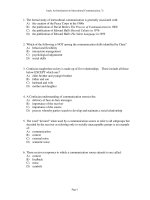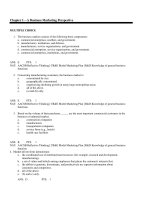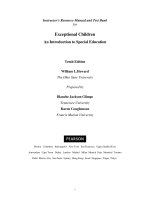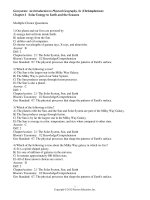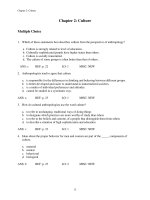Introduction to management science 11th edition taylor test bank
Bạn đang xem bản rút gọn của tài liệu. Xem và tải ngay bản đầy đủ của tài liệu tại đây (335.44 KB, 33 trang )
Introduction to Management Science, 11e (Taylor)
Chapter 2 Linear Programming: Model Formulation and Graphical Solution
1) Linear programming is a model consisting of linear relationships representing a firm's decisions given
an objective and resource constraints.
Answer: TRUE
Diff: 2 Page Ref: 31
Section Heading: Model Formulation
Keywords: model formulation
AACSB: Analytic skills
2) The objective function always consists of either maximizing or minimizing some value.
Answer: TRUE
Diff: 2 Page Ref: 31
Section Heading: Model Formulation
Keywords: objective function
AACSB: Analytic skills
3) The objective function is a linear relationship reflecting the objective of an operation.
Answer: TRUE
Diff: 1 Page Ref: 31
Section Heading: Model Formulation
Keywords: model formulation
AACSB: Analytic skills
4) A constraint is a linear relationship representing a restriction on decision making.
Answer: TRUE
Diff: 1 Page Ref: 31
Section Heading: Model Formulation
Keywords: model formulation
AACSB: Analytic skills
5) A linear programming model consists of only decision variables and constraints.
Answer: FALSE
Diff: 1 Page Ref: 56
Section Heading: Characteristics of Linear Programming Problems
Keywords: model formulation
AACSB: Analytic skills
6) A parameter is a numerical value in the objective function and constraints.
Answer: TRUE
Diff: 1 Page Ref: 31
Section Heading: Model Formulation
Keywords: parameter
AACSB: Analytic skills
1
Copyright © 2013 Pearson Higher Education, Inc. Publishing as Prentice Hall
7) A feasible solution violates at least one of the constraints.
Answer: FALSE
Diff: 2 Page Ref: 34
Section Heading: Model Formulation
Keywords: model formulation
AACSB: Analytic skills
8) Proportionality means the slope of a constraint is proportional to the slope of the objective function.
Answer: FALSE
Diff: 2 Page Ref: 56
Section Heading: Characteristics of Linear Programming Problems
Keywords: properties of linear programming models, proportionality
AACSB: Analytic skills
9) The terms in the objective function or constraints are additive.
Answer: TRUE
Diff: 2 Page Ref: 56
Section Heading: Characteristics of Linear Programming Problems
Keywords: properties of linear programming models, additive
AACSB: Analytic skills
10) The terms in the objective function or constraints are multiplicative.
Answer: FALSE
Diff: 2 Page Ref: 56
Section Heading: Characteristics of Linear Programming Problems
Keywords: properties of linear programming models, additive
AACSB: Analytic skills
11) The values of decision variables are continuous or divisible.
Answer: TRUE
Diff: 2 Page Ref: 56
Section Heading: Characteristics of Linear Programming Problems
Keywords: properties of linear programming models, divisible
AACSB: Analytic skills
12) All model parameters are assumed to be known with certainty.
Answer: TRUE
Diff: 2 Page Ref: 56
Section Heading: Characteristics of Linear Programming Problems
Keywords: properties of linear programming models
AACSB: Analytic skills
13) In linear programming models , objective functions can only be maximized.
Answer: FALSE
Diff: 1 Page Ref: 31
Section Heading: Model Formulation
Keywords: properties of linear programming models, objective function
AACSB: Analytic skills
2
Copyright © 2013 Pearson Higher Education, Inc. Publishing as Prentice Hall
14) All linear programming models exhibit a set of constraints.
Answer: TRUE
Diff: 1 Page Ref: 30
Section Heading: Model Formulation
Keywords: properties of linear programming models, constraints
AACSB: Analytic skills
15) When using the graphical method, only one of the four quadrants of an xy-axis needs to be drawn.
Answer: TRUE
Diff: 1 Page Ref: 36
Section Heading: Graphical Solutions of Linear Programming Models
Keywords: graphical linear programming
AACSB: Analytic skills
16) Linear programming models exhibit linearity among all constraint relationships and the objective
function.
Answer: TRUE
Diff: 1 Page Ref: 55
Section Heading: Characteristics of Linear Programming Problems
Keywords: properties of linear prog models, linearity, proportionality
AACSB: Analytic skills
17) The equation 8xy = 32 satisfies the proportionality property of linear programming.
Answer: FALSE
Diff: 2 Page Ref: 56
Section Heading: Characteristics of Linear Programming Problems
Keywords: graphical solution, proportionality
AACSB: Analytic skills
18) Typically, finding a corner point for the feasible region involves solving a set of three simultaneous
equations.
Answer: FALSE
Diff: 2 Page Ref: 46
Section Heading: Graphical Solutions of Linear Programming Models
Keywords: graphical solution, extreme points, feasible region
AACSB: Analytic skills
19) Objective functions in linear programs always minimize costs.
Answer: FALSE
Diff: 2 Page Ref: 31
Section Heading: Model Formulation
Keywords: properties of linear programming models, objective function
AACSB: Analytic skills
20) The feasible solution area contains infinite solutions to the linear program.
Answer: TRUE
Diff: 1 Page Ref: 38
Section Heading: Graphical Solutions of Linear Programming Models
Keywords: properties of linear programming models, feasible solution area
AACSB: Analytic skills
3
Copyright © 2013 Pearson Higher Education, Inc. Publishing as Prentice Hall
21) There is exactly one optimal solution point to a linear program.
Answer: FALSE
Diff: 2 Page Ref: 53
Section Heading: Irregular Types of Linear Programming Problems
Keywords: properties of linear programming models, optimal solution pt
AACSB: Analytic skills
22) The following equation represents a resource constraint for a maximization problem: X + Y ≥ 20.
Answer: FALSE
Diff: 2 Page Ref: 34
Section Heading: A Maximization Model Example
Keywords: properties of linear programming models, constraints
AACSB: Analytic skills
23) The optimal solution for a graphical linear programming problem is the corner point that is the
farthest from the origin.
Answer: FALSE
Diff: 2 Page Ref: 41
Section Heading: Graphical Solutions of Linear Programming Models
Keywords: feasibility, constraints
AACSB: Analytic skills
24) A minimization model of a linear program contains only surplus variables.
Answer: FALSE
Diff: 1 Page Ref: 52
Section Heading: A Minimization Model Example
Keywords: properties of linear programming models, surplus variables
AACSB: Analytic skills
25) In the graphical approach, simultaneous equations may be used to solve for the optimal solution
point.
Answer: TRUE
Diff: 2 Page Ref: 42
Section Heading: Graphical Solutions of Linear Programming Models
Keywords: graphical solution
AACSB: Analytic skills
26) Slack variables are only associated with maximization problems.
Answer: FALSE
Diff: 2 Page Ref: 44
Section Heading: Graphical Solutions of Linear Programming Models
Keywords: graphical solution, slack variables
AACSB: Analytic skills
4
Copyright © 2013 Pearson Higher Education, Inc. Publishing as Prentice Hall
27) Surplus variables are only associated with minimization problems.
Answer: FALSE
Diff: 2 Page Ref: 52
Section Heading: A Minimization Model Example
Keywords: graphical solution, surplus variable
AACSB: Analytic skills
28) If the objective function is parallel to a constraint, the constraint is infeasible.
Answer: FALSE
Diff: 2 Page Ref: 54
Section Heading: Irregular Types of Linear Programming Problems
Keywords: graphical solution
AACSB: Analytic skills
29) Multiple optimal solutions occur when constraints are parallel to each other.
Answer: FALSE
Diff: 2 Page Ref: 54
Section Heading: Irregular Types of Linear Programming Problems
Keywords: graphical solution
AACSB: Analytic skills
30) Graphical solutions to linear programming problems have an infinite number of possible objective
function lines.
Answer: TRUE
Diff: 2 Page Ref: 39
Section Heading: Graphical Solutions of Linear Programming Models
Keywords: graphical solution, objective function line
AACSB: Analytic skills
31) The first step in formulating a linear programming model is to define the objective function
Answer: FALSE
Diff: 2 Page Ref: 32
Section Heading: Introduction
Keywords: linear programming problems, formulation
AACSB: Analytic skills
32) ________ are mathematical symbols representing levels of activity.
Answer: Decision variables
Diff: 1 Page Ref: 31
Section Heading: Model Formulation
Keywords: decision variables, model formulation
AACSB: Analytic skills
33) The ________ is a linear relationship reflecting the objective of an operation.
Answer: objective function
Diff: 1 Page Ref: 31
Section Heading: Model Formulation
Keywords: objective function, model formulation
AACSB: Analytic skills
5
Copyright © 2013 Pearson Higher Education, Inc. Publishing as Prentice Hall
34) A ________ is a linear relationship representing a restriction on decision making.
Answer: constraint
Diff: 1 Page Ref: 31
Section Heading: Model Formulation
Keywords: constraint, model formulation
AACSB: Analytic skills
35) A manufacturer using linear programming to decide the best product mix to maximize profit
typically has a(n) ________ constraint included in the model.
Answer: nonnegativity
Diff: 1 Page Ref: 34
Section Heading: A Maximization Model Example
Keywords: nonnegativity
AACSB: Analytic skills
36) If at least one constraint in a linear programming model is violated, the solution is said to be
________.
Answer: infeasible
Diff: 1 Page Ref: 54
Section Heading: Irregular Types of Linear Programming Problems
Keywords: constraint, infeasible solution
AACSB: Analytic skills
37) A graphical solution is limited to solving linear programming problems with ________ decision
variables
Answer: two
Diff: 1 Page Ref: 35
Section Heading: Graphical Solutions of Linear Programming Models
Keywords: graphical solution
AACSB: Analytic skills
38) The ________ solution area is an area bounded by the constraint equations.
Answer: feasible
Diff: 1 Page Ref: 38
Section Heading: Graphical Solutions of Linear Programming Models
Keywords: graphical solution
AACSB: Analytic skills
39) Multiple optimal solutions can occur when the objective function line is ________ to a constraint
line.
Answer: parallel
Diff: 2 Page Ref: 44
Section Heading: Graphical Solutions of Linear Programming Models
Keywords: graphical solution, multiple optimal solutions
AACSB: Analytic skills
6
Copyright © 2013 Pearson Higher Education, Inc. Publishing as Prentice Hall
40) When a maximization problem is ________, the objective function can increase indefinitely without
reaching a maximum value.
Answer: unbounded
Diff: 2 Page Ref: 55
Section Heading: Irregular Types of Linear Programming Problems
Keywords: graphical solution, unbounded problem
AACSB: Analytic skills
41) A linear programming problem that results in a solution that is ________ usually indicates that the
linear program has been incorrectly formulated.
Answer: infeasible
Diff: 2 Page Ref: 54
Section Heading: Irregular Types of Linear Programming Problems
Keywords: graphical solution, infeasible solution
AACSB: Analytic skills
42) The best feasible solution is ________.
Answer: optimal
Diff: 1 Page Ref: 40
Section Heading: Graphical Solutions of Linear Programming Models
Keywords: optimal solutions
AACSB: Analytic skills
43) In a constraint, the ________ variable represents unused resources.
Answer: slack
Diff: 1 Page Ref: 44
Section Heading: Graphical Solutions of Linear Programming Models
Keywords: graphical solution, surplus variable
AACSB: Analytic skills
44) ________ is the difference between the left- and right-hand sides of a greater than or equal to
constraint.
Answer: Surplus
Diff: 1 Page Ref: 52
Section Heading: A Minimization Model Example
Keywords: surplus
AACSB: Analytic skills
45) If the objective function is parallel to a constraint, the linear program could have ________.
Answer: multiple optimal solutions
Diff: 2 Page Ref: 44
Section Heading: Graphical Solutions of Linear Programming Models
Keywords: graphical solutions, multiple optimal solutions
AACSB: Analytic skills
7
Copyright © 2013 Pearson Higher Education, Inc. Publishing as Prentice Hall
46) Corner points on the boundary of the feasible solution area are called ________ points.
Answer: extreme
Diff: 1 Page Ref: 41
Section Heading: Graphical Solutions of Linear Programming Models
Keywords: feasibility, constraints
AACSB: Analytic skills
47) ________ are at the endpoints of the constraint line segment that the objective function parallels.
Answer: Alternate optimal solutions
Diff: 3 Page Ref: 54
Section Heading: Irregular Types of Linear Programming Problems
Keywords: alternative optimal solutions, multiple optimal solutions
AACSB: Analytic skills
48) The ________ step in formulating a linear programming model is to define the decision variables.
Answer: first
Diff: 1 Page Ref: 33
Section Heading: A Maximization Model Example
Keywords: linear programming, formulation
AACSB: Analytic skills
49) The management scientist constructed a linear program to help the alchemist maximize his gold
production process. The computer model chugged away for a few minutes and returned an answer of
infinite profit., which is what might be expected from a(n) ________ problem.
Answer: unbounded
Diff: 1 Page Ref: 55
Section Heading: Irregular Types of Linear Programming Problems
Keywords: unbounded
AACSB: Analytic skills
50) The ________ property of linear programming models indicates that the values of all the model
parameters are known and are assumed to be constant.
Answer: certainty
Diff: 2 Page Ref: 56
Section Heading: Characteristics of Linear Programming Problems
Keywords: properties of linear programming models, certainty
AACSB: Analytic skills
51) The ________ property of linear programming models indicates that the rate of change, or slope, of
the objective function or a constraint is constant.
Answer: proportionality or linearity
Diff: 2 Page Ref: 56
Section Heading: Characteristics of Linear Programming Problems
Keywords: properties of linear programming models, certainty
AACSB: Analytic skills
8
Copyright © 2013 Pearson Higher Education, Inc. Publishing as Prentice Hall
52) The ________ property of linear programming models indicates that the decision variables cannot
be restricted to integer values and can take on any fractional value.
Answer: divisibility
Diff: 2 Page Ref: 56
Section Heading: Characteristics of Linear Programming Problems
Keywords: properties of linear programming models, divisibility
AACSB: Analytic skills
53) The constraint 2X +XY violates the ________ property of linear programming.
Answer: proportionality or linear
Diff: 1 Page Ref: 56
Section Heading: Characteristics of Linear Programming Problems
Keywords: properties of linear programming models
AACSB: Analytic skills
54) Consider the following minimization problem:
Min z = x1 + 2x2
s.t.
x1 + x2 ≥ 300
2x1 + x2 ≥ 400
2x1 + 5x2 ≤ 750
x1, x2 ≥ 0
What is the optimal solution?
Answer: x1 = 250, x2 = 50, z = 350
Diff: 3 Page Ref: 47-53
Section Heading: A Minimization Model Example
Keywords: Graphical solution, simultaneous solution
AACSB: Analytic skills
55) Consider the following minimization problem:
Min z = x1 + 2x2
s.t.
x1 + x2 ≥ 300
2x1 + x2 ≥ 400
2x1 + 5x2 ≤ 750
x1, x2 ≥ 0
Which constraints are binding at the optimal solution? (x1 =250, x2 = 50)
Answer: constraints 1 and 3
Diff: 1 Page Ref: 47-53
Section Heading: A Minimization Model Example
Keywords: Graphical solution, simultaneous solution
AACSB: Analytic skills
9
Copyright © 2013 Pearson Higher Education, Inc. Publishing as Prentice Hall
56) Solve the following graphically:
Max z = 3x1 + 4x2
s.t.
x1 + 2x2 ≤ 16
2x1 + 3x2 ≤ 18
x1
≥2
x2 ≤ 10
x1, x2 ≥ 0
What are the optimal values of x1, x2, and z?
Answer: x1 = 9, x2 = 0, z = 27
Diff: 3 Page Ref: 35-46
Section Heading: Graphical Solutions of Linear Programming Models
Keywords: graphical solution, simultaneous solution
AACSB: Analytic skills
10
Copyright © 2013 Pearson Higher Education, Inc. Publishing as Prentice Hall
57) Consider the following linear program:
MAX
s.t.
Z = 60A + 50B
10A + 20B ≤ 200
8A + 5B ≤ 80
A≥2
B≥5
Solve this linear program graphically and determine the optimal quantities of A, B, and the value of Z.
Answer: Solution shown below.
Diff: 2 Page Ref: 35-46
Section Heading: Graphical Solutions of Linear Programming Models
Keywords: graphical linear programming
AACSB: Analytic skills
11
Copyright © 2013 Pearson Higher Education, Inc. Publishing as Prentice Hall
58) Consider the following linear program:
MIN
s.t.
Z = 60A + 50B
10A + 20B ≤ 200
8A + 5B ≤ 80
A≥2
B≥5
Solve this linear program graphically and determine the optimal quantities of A, B, and the value of Z.
Answer: A = 2, B = 5, Z = 370
Diff: 2 Page Ref: 35-46
Section Heading: Graphical Solutions of Linear Programming Models
Keywords: graphical linear programming
AACSB: Analytic skills
12
Copyright © 2013 Pearson Higher Education, Inc. Publishing as Prentice Hall
59) A graphical representation of a linear program is shown below. The shaded area represents the
feasible region, and the dashed line in the middle is the slope of the objective function.
If this is a maximization, which extreme point is the optimal solution?
Answer: E
Diff: 1 Page Ref: 41
Section Heading: Graphical Solutions of Linear Programming Models
Keywords: graphical solution, extreme points, feasible region
AACSB: Analytic skills
60) A graphical representation of a linear program is shown below. The shaded area represents the
feasible region, and the dashed line in the middle is the slope of the objective function.
If this is a minimization, which extreme point is the optimal solution?
Answer: A
Diff: 2 Page Ref: 41
Section Heading: Graphical Solutions of Linear Programming Models
Keywords: graphical solution, extreme points, feasible region
AACSB: Analytic skills
13
Copyright © 2013 Pearson Higher Education, Inc. Publishing as Prentice Hall
61) A graphical representation of a linear program is shown below. The shaded area represents the
feasible region, and the dashed line in the middle is the slope of the objective function.
What would the be the new slope of the objective function if multiple optimal solutions occurred along
line segment AB?
Answer: -3/2
Diff: 2 Page Ref: 44
Section Heading: Irregular Types of Linear Programming Problems
Keywords: graphical solution, multiple optimal solutions
AACSB: Analytic skills
62) Consider the following linear programming problem:
Max Z = $15x + $20y
Subject to:
8x + 5y ≤ 40
0.4x + y ≥ 4
x, y ≥ 0
Determine the values for x and y that will maximize revenue. Given this optimal revenue, what is the
amount of slack associated with the first constraint?
Answer: x = 0, y = 8, revenue = $160, s1= 0
Diff: 2 Page Ref: 44
Section Heading: Graphical Solutions of Linear Programming Models
Keywords: graphical solution, slack variables
AACSB: Analytic skills
14
Copyright © 2013 Pearson Higher Education, Inc. Publishing as Prentice Hall
63) Consider the following linear programming problem:
Max Z =
$3x + $9y
Subject to:
20x + 32y ≤ 1600
4x + 2y ≤ 240
y ≤ 40
x, y ≥ 0
Solve for the quantities of x and y which will maximize Z. What is the value of the slack variable
associated with constraint 2?
Answer: x = 16, y = 40, z = $408 and slack (s2) = 96
Diff: 2 Page Ref: 44
Section Heading: Graphical Solutions of Linear Programming Models
Keywords: graphical solution, slack variables
AACSB: Analytic skills
64) Consider the following linear programming problem:
Max Z =
5x1 + 3x2
Subject to:
6x1 + 2x2 ≤ 18
15x1 + 20x2 ≤ 60
x1 , x2 ≥ 0
Find the optimal profit and the values of x1 and x2 at the optimal solution.
Answer: Z = 16.333, x1 = 2.6667, x2 = 1.0
Diff: 2 Page Ref: 42
Section Heading: Graphical Solutions of Linear Programming Models
Keywords: graphical solution
AACSB: Analytic skills
65) The poultry farmer decided to make his own chicken scratch by combining alfalfa and corn in rail
car quantities. A rail car of corn costs $400 and a rail car of alfalfa costs $200. The farmer's chickens
have a minimum daily requirement of vitamin K (500 milligrams) and iron (400 milligrams), but it
doesn't matter whether those elements come from corn, alfalfa, or some other grain. A unit of corn
contains 150 milligrams of vitamin K and 75 milligrams of iron. A unit of alfalfa contains 250
milligrams of vitamin K and 50 milligrams of iron. Formulate the linear programming model for this
situation.
Answer: Min Z =
$4005C + $200A
Subject to:
150C + 250A ≥ 500
75C + 50A ≥ 400
C, A ≥ 0
Diff: 3 Page Ref: 34
Section Heading: A Maximization Model Example
Keywords: constraint, model formulation
AACSB: Analytic skills
15
Copyright © 2013 Pearson Higher Education, Inc. Publishing as Prentice Hall
66) Consider the following linear programming problem:
Max Z =
3x1 + 3x2
Subject to:
10x1 + 4x2 ≤ 60
25x1 + 50x2 ≤ 200
x1, x2 ≥ 0
Find the optimal profit and the values of x1 and x2 at the optimal solution.
Answer: Z = 20.25, x1 = 5.5, x2 = 1.25
Diff: 2 Page Ref: 34-42
Section Heading: Graphical Solutions of Linear Programming Models
Keywords: graphical solution
AACSB: Analytic skills
67) Consider the following linear programming problem:
MIN Z =
10x1 + 20x2
Subject to:
x1 + x2 ≥ 12
2x1 + 5x2 ≥ 40
x2 ≤ 13
x1, x2 ≥ 0
What is minimum cost and the value of x1 and x2 at the optimal solution?
Answer: Z = 173.333, x1 = 6.667, x2 = 5.333
Diff: 2 Page Ref: 47-53
Section Heading: A Minimization Model Example
Keywords: graphical solution
AACSB: Analytic skills
68) Consider the following linear programming problem:
MIN Z =
3x1 + 2x2
Subject to:
2x1 + 3x2 ≥ 12
5x1 + 8x2 ≥ 37
x1, x2 ≥ 0
What is minimum cost and the value of x1 and x2 at the optimal solution?
Answer: 9.25 at x1 = 0 and x2 = 4.625
Diff: 3 Page Ref: 42
Section Heading: Graphical Solutions of Linear Programming Models
Keywords: minimization problem
AACSB: Analytic skills
16
Copyright © 2013 Pearson Higher Education, Inc. Publishing as Prentice Hall
69) Consider the following linear programming problem:
MIN Z =
3x1 + 2x2
Subject to:
2x1 + 3x2 ≥ 12
5x1 + 8x2 ≥ 37
x1, x2 ≥ 0
At the optimal solution point, the objective function value is 18. If the constraints are changed from
greater than to less than constraints and the objective function is changed from minimize to maximize,
what happens to the optimal solution? Demonstrate whether it falls at the same optimal point.
Answer: No, reversing the signs for the constraints and the objective function does not typically retain
the same optimal solution. In this case, at x2 = 4.625 the new objective function value is 9.25. In the
original formulation the optimal value was at x1 = 6.
Diff: 3 Page Ref: 42
Section Heading: A Minimization Model Example
Keywords: optimal solutions
AACSB: Analytic skills
70) Consider the following linear programming problem:
MIN Z =
10x1 + 20x2
Subject to:
x1 + x2 ≥ 12
2x1 + 5x2 ≥ 40
x2 ≤ 13
x1, x2 ≥ 0
At the optimal solution, what is the value of surplus associated with constraint 1 and constraint 3,
respectively?
Answer: constraint 1: (0 surplus), constraint 2: (7.667 surplus)
Diff: 2 Page Ref: 47-53
Section Heading: A Minimization Model Example
Keywords: graphical solution
AACSB: Analytic skills
71) Given this set of constraints, for what objective function is the point x=5, y=3 in the feasible region?
s.t
3x + 6y ≤ 30
10x + 10y ≤ 60
10x + 15y ≤ 90
Answer: No objective function can move that point into the feasible region.
Diff: 2 Page Ref: 40
Section Heading: Graphical Solutions of Linear Programming Models
Keywords: feasibility, constraints
AACSB: Analytic skills
17
Copyright © 2013 Pearson Higher Education, Inc. Publishing as Prentice Hall
72) Consider the following linear programming problem:
MIN Z =
2x1 + 3x2
Subject to:
x1 + 2x2 ≤ 20
5x1 + x2 ≤ 40
4x1 +6x2 ≤ 60
x1 , x2 ≥ 0
What is the optimal solution?
Answer: Multiple optimal solutions exist between the extreme point (0,10) and (6.92,5.38) along the
line with a slope of -2/3.
Diff: 2 Page Ref: 47-53
Section Heading: A Minimization Model Example
Keywords: graphical solution, multiple optimal solutions
AACSB: Analytic skills
73) A company producing a standard line and a deluxe line of dishwashers has the following time
requirements (in minutes) in departments where either model can be processed.
Standard
Stamping
3
Motor installation 10
Wiring
10
Deluxe
6
10
15
The standard models contribute $20 each and the deluxe $30 each to profits. Because the company
produces other items that share resources used to make the dishwashers, the stamping machine is
available only 30 minutes per hour, on average. The motor installation production line has 60 minutes
available each hour. There are two lines for wiring, so the time availability is 90 minutes per hour.
Let
x = number of standard dishwashers produced per hour
y = number of deluxe dishwashers produced per hour
Write the formulation for this linear program.
Answer: Max 20x + 30y
s.t
3x + 6y ≤ 30
10x + 10y ≤ 60
10x + 15y ≤ 90
Diff: 2 Page Ref: 33
Section Heading: A Maximization Model Example
Keywords: formulation, objective function, constraints
AACSB: Analytic skills
18
Copyright © 2013 Pearson Higher Education, Inc. Publishing as Prentice Hall
74) In a linear programming problem, the binding constraints for the optimal solution are:
5x1 + 3x2 ≤ 30
2x1 + 5x2 ≤ 20
As long as the slope of the objective function stays between ________ and ________, the current
optimal solution point will remain optimal.
Answer: -5/3, -2/5
Diff: 3 Page Ref: 44
Section Heading: Graphical Solutions of Linear Programming Models
Keywords: optimal solution, solution interpretation, slope
AACSB: Analytic skills
75) In a linear programming problem, the binding constraints for the optimal solution are:
5x1 + 3x2 ≤ 30
2x1 + 5x2 ≤ 20
Which of these objective functions will lead to the same optimal solution?
A) 2x1 + 1x2
B) 7x1 + 8x2
C) 80x1 + 60x2
D) 25x1 + 15x2
Answer: D
Diff: 3 Page Ref: 39
Section Heading: Graphical Solutions of Linear Programming Models
Keywords: optimal solution, solution interpretation, slope
AACSB: Analytic skills
76) Decision variables
A) measure the objective function.
B) measure how much or how many items to produce, purchase, hire, etc.
C) always exist for each constraint.
D) measure the values of each constraint.
Answer: B
Diff: 2 Page Ref: 31
Section Heading: Model Formulation
Keywords: decision variables
AACSB: Analytic skills
77) In a linear programming problem, a valid objective function can be represented as:
A) Max Z = 5xy
B) Max Z 5x2 + 2y2
C) Max 3x + 3y + 1/3 z
D) Min (x1 + x2) / x3
Answer: C
Diff: 3 Page Ref: 56
Section Heading: Characteristics of Linear Programming Problems
Keywords: objective function
AACSB: Analytic skills
19
Copyright © 2013 Pearson Higher Education, Inc. Publishing as Prentice Hall
78) Which of the following could not be a linear programming problem constraint?
A) 1A + 2B ≠ 3
B) 1A + 2B = 3
C) 1A + 2B ≤ 3
D) 1A + 2B ≥ 3
Answer: A
Diff: 2 Page Ref: 33
Section Heading: A Maximization Model Example
Keywords: formulation, constraints
AACSB: Analytic skills
79) A linear programming model consists of
A) decision variables.
B) an objective function.
C) constraints.
D) all of the above
Answer: D
Diff: 1 Page Ref: 31
Section Heading: Model Formulation
Keywords: components of linear programming
AACSB: Analytic skills
80) The minimization of cost or maximization of profit is the
A) constraint of operations management.
B) goal of management science.
C) objective of linear programming.
D) assumption of financiality.
Answer: C
Diff: 1 Page Ref: 31
Section Heading: Model Formulation
Keywords: objective, cost minimization, profit maximization
AACSB: Analytic skills
81) Which of the following could be a linear programming objective function?
A) Z = 1A + 2BC + 3D
B) Z = 1A + 2B + 3C + 4D
C) Z = 1A + 2B / C + 3D
D) Z = 1A + 2B2 + 3D
Answer: B
Diff: 2 Page Ref: 56
Section Heading: Characteristics of Linear Programming Problems
Keywords: objective function
AACSB: Analytic skills
20
Copyright © 2013 Pearson Higher Education, Inc. Publishing as Prentice Hall
82) The production manager for the Coory soft drink company is considering the production of two
kinds of soft drinks: regular (R) and diet (D). Two of her limited resources are production time (8 hours
= 480 minutes per day) and syrup (1 of the ingredients), limited to 675 gallons per day. To produce a
regular case requires 2 minutes and 5 gallons of syrup, while a diet case needs 4 minutes and 3 gallons
of syrup. Profits for regular soft drink are $3.00 per case and profits for diet soft drink are $2.00 per
case. What is the objective function?
A) MAX $2R + $4D
B) MAX $3R + $2D
C) MAX $3D + $2R
D) MAX $4D + $2R
Answer: B
Diff: 2 Page Ref: 32
Section Heading: A Maximization Model Example
Keywords: formulation, objective function
AACSB: Analytic skills
83) The production manager for the Coory soft drink company is considering the production of two
kinds of soft drinks: regular (R) and diet(D). Two of the limited resources are production time (8 hours =
480 minutes per day) and syrup (1 of the ingredients), limited to 675 gallons per day. To produce a
regular case requires 2 minutes and 5 gallons of syrup, while a diet case needs 4 minutes and 3 gallons
of syrup. Profits for regular soft drink are $3.00 per case and profits for diet soft drink are $2.00 per
case. What is the time constraint?
A) 2D + 4R ≤ 480
B) 2R + 3D ≤ 480
C) 3R + 2D ≤ 480
D) 2R + 4D ≤ 480
Answer: D
Diff: 2 Page Ref: 32
Section Heading: A Maximization Model Example
Keywords: formulation, constraints
AACSB: Analytic skills
84) Non-negativity constraints
A) require the use of greater-than-or-equal-to constraints.
B) restrict the decision variables to positive values.
C) restrict the decision variables to negative values.
D) do not restrict the sign of the decision variable.
Answer: B
Diff: 2 Page Ref: 34
Section Heading: A Maximization Model Example
Keywords: constraints
AACSB: Analytic skills
21
Copyright © 2013 Pearson Higher Education, Inc. Publishing as Prentice Hall
85) Cully Furniture buys two products for resale: big shelves (B) and medium shelves (M). Each big
shelf costs $500 and requires 100 cubic feet of storage space, and each medium shelf costs $300 and
requires 90 cubic feet of storage space. The company has $75,000 to invest in shelves this week, and the
warehouse has 18,000 cubic feet available for storage. Profit for each big shelf is $300 and for each
medium shelf is $150. What is the objective function?
A) MAX Z = $300 B + $100 M
B) MAX Z = $300 M + $150 B
C) MAX Z = $300 B + $150 M
D) MAX Z = $300 B + $500 M
Answer: C
Diff: 2 Page Ref: 33
Section Heading: A Maximization Model Example
Keywords: formulation, objective function
AACSB: Analytic skills
86) Cully Turniture buys two products for resale: big shelves (B) and medium shelves (M). Each big
shelf costs $500 and requires 100 cubic feet of storage space, and each medium shelf costs $300 and
requires 90 cubic feet of storage space. The company has $75,000 to invest in shelves this week, and the
warehouse has 18,000 cubic feet available for storage. Profit for each big shelf is $300 and for each
medium shelf is $150. What is the storage space constraint?
A) 90 B + 100 M ≥ 18000
B) 90 B + 100 M ≤ 18000
C) 100 B + 90 M ≤ 18000
D) 500 B + 300 M ≤ 18000
Answer: C
Diff: 2 Page Ref: 34
Section Heading: A Maximization Model Example
Keywords: formulation, constraints
AACSB: Analytic skills
87) The ________ property of linear programming models indicates that the decision variables cannot
be restricted to integer values and can take on any fractional value.
A) linearity
B) additive
C) divisibility
D) proportionality
Answer: C
Diff: 2 Page Ref: 56
Section Heading: Characteristics of Linear Programming Problems
Keywords: properties of linear programming models
AACSB: Analytic skills
22
Copyright © 2013 Pearson Higher Education, Inc. Publishing as Prentice Hall
88) The ________ property of linear programming models indicates that the rate of change or slope of
the objective function or a constraint is constant.
A) additive
B) divisibility
C) certainty
D) proportionality
Answer: D
Diff: 2 Page Ref: 56
Section Heading: Characteristics of Linear Programming Problems
Keywords: properties of linear programming models
AACSB: Analytic skills
89) The ________ property of linear programming models indicates that the values of all the model
parameters are known and are assumed to be constant.
A) additive
B) divisibility
C) certainty
D) proportionality
Answer: C
Diff: 2 Page Ref: 56
Section Heading: Characteristics of Linear Programming Problems
Keywords: properties of linear programming models
AACSB: Analytic skills
90) The region that satisfies all of the constraints in a graphical linear programming problem is called
the
A) region of optimality.
B) feasible solution space.
C) region of non-negativity.
D) optimal solution space.
Answer: B
Diff: 1 Page Ref: 38
Section Heading: Graphical Solutions of Linear Programming Models
Keywords: graphical solution, feasibility
AACSB: Analytic skills
91) In the formulation of a ≥ constraint,
A) a surplus variable is subtracted.
B) a surplus variable is added.
C) a slack variable is subtracted.
D) a slack variable is added.
Answer: A
Diff: 1 Page Ref: 52
Section Heading: A Minimization Model Example
Keywords: surplus
AACSB: Analytic skills
23
Copyright © 2013 Pearson Higher Education, Inc. Publishing as Prentice Hall
92) Which of the following statements is not true?
A) An infeasible solution violates all constraints.
B) A feasible solution point does not have to lie on the boundary of the feasible solution.
C) A feasible solution satisfies all constraints.
D) An optimal solution satisfies all constraints.
Answer: A
Diff: 2 Page Ref: 38
Section Heading: Graphical Solutions of Linear Programming Models
Keywords: graphical solution, feasibility
AACSB: Analytic skills
93) A hot dog manufacturer wishes to minimize the cost in dollars of producing a low-cost niched
product while meeting the dietary guidelines for protein and sodium. Once the model has been run, the
surplus variable in the sodium constraint has a value of 1300 milligrams. The best interpretation of this
outcome is:
A) The value of the sodium in a hot dog is 1300.
B) The amount of sodium in a single hot dog should be 1300 milligrams.
C) The minimum cost hot dog has 1300 milligrams more sodium than required.
D) A hot dog should have at least 1300 milligrams of sodium.
Answer: C
Diff: 2 Page Ref: 52
Section Heading: A Minimization Model Example
Keywords: surplus
AACSB: Analytic skills
94) Which of these statements is best?
A) An unbounded problem is also infeasible.
B) An infeasible problem is also unbounded.
C) An unbounded problem has feasible solutions.
D) An infeasible problem has unbounded solutions.
Answer: C
Diff: 2 Page Ref: 55
Section Heading: Irregular Types of Linear Programming Problems
Keywords: infeasible problem, infeasible solution
AACSB: Analytic skills
95) The optimal solution to a linear programming model that has been solved using the graphical
approach
A) is typically located at the origin.
B) must be below and on the left side of all constraint lines.
C) must be above and the the right of all constraint lines.
D) is typically at some corner of the feasible region.
Answer: A
Diff: 1 Page Ref: 39
Section Heading: Graphical Solutions of Linear Programming Models
Keywords: solution
AACSB: Analytic skills
24
Copyright © 2013 Pearson Higher Education, Inc. Publishing as Prentice Hall
96) Without satisfying the non-negativity constraint, a solution that satisfies all the other constraints of a
linear programming problem is called
A) feasible.
B) infeasible.
C) semi-feasible.
D) optimal.
Answer: B
Diff: 3 Page Ref: 38
Section Heading: Graphical Solutions of Linear Programming Models
Keywords: graphical solution, feasibility
AACSB: Analytic skills
97) An intern sets up a linear program to optimize the use of paper products in the men's washroom. The
system of equations he develops is:
Max 2T + 3S + 4ST
s.t
3T + 6S ≤ 40
10T + 10S ≤ 66
10T + 15S ≤ 99
His mentor studies the model, frowns, and admonishes the intern for violating which of the following
properties of linear programming models?
A) Divisibility
B) Proportionality
C) Certainty
D) Additivity
Answer: D
Diff: 1 Page Ref: 56
Section Heading: Characteristics of Linear Programming Problems
Keywords: additivity
AACSB: Analytic skills
98) Which of the following is not a typical characteristic of a linear programming problem?
A) Restrictions exist.
B) A choice among alternatives is required.
C) The problem can be solved graphically.
D) The problem has an objective.
Answer: C
Diff: 1 Page Ref: 56
Section Heading: Characteristics of Linear Programming Problems
Keywords: graphical solution
AACSB: Analytic skills
25
Copyright © 2013 Pearson Higher Education, Inc. Publishing as Prentice Hall

